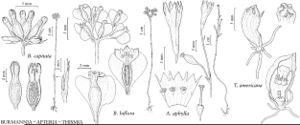Burmannia biflora
Sp. Pl. 1: 287. 1753.
Illustrated
Revision as of 04:19, 30 July 2020 by imported>Volume Importer
Stems 3–18 cm. Leaves: basal leaves absent; cauline leaves subulate to lanceolate, 1–4 × 0.2–1 mm. Inflorescences loosely 2–12–flowered cymes, 2-cleft, or flowers solitary; cyme rachis usually distinct, to 2.5 cm; floral bracts subulate to lanceolate, 1.5–3.2 mm. Flowers 3-winged, 3–6 mm, wings blue, to 2.5 mm wide; perianth blue to violet, often with cream-colored lobes; perianth-tube 6-lobed; outer lobes triangular, 0.5–1 mm; inner lobes erect, elliptic, 0.4–0.8 mm; pedicel 0–1 mm. Capsules 2–3.5 mm.
Phenology: Flowering summer–fall.
Habitat: Low woods, pond margins, savannas, bogs, swamps, ditches, pine barrens
Elevation: 0–100 m
Distribution

Ala., Fla., Ga., La., Miss., N.C., S.C., Tex., Va., West Indies (Cuba)
Discussion
Selected References
None.
Lower Taxa
None.
... more about "Burmannia biflora"
absent +
absent +
few +
dehiscent +
obovoid;ellipsoid +
appendaged +
broadened +
2-12-flowered +
distinct +
3-winged +
capitate +
erect +
transverse +
longitudinal +
Present +
elliptic +
erect +
imbricate +
alternate +
absent +
scalelike;linear +
cream-colored +
triangular +
axile +
inferior +
numerous +
6-lobed +
blue;violet +
persistent +
separated +
connate +
proximal +
Sp. Pl. +
1753 +
absent +
subterranean +
filiform +
mycorrhizal +
numerous +
Illustrated +
sessile +
unbranched +
green +
erect +
absent +
3-branched +
Burmannia biflora +
Burmannia +
species +
connate +
irregular +
annual +
autotrophic +
blue +
0mm;2.5mm +
